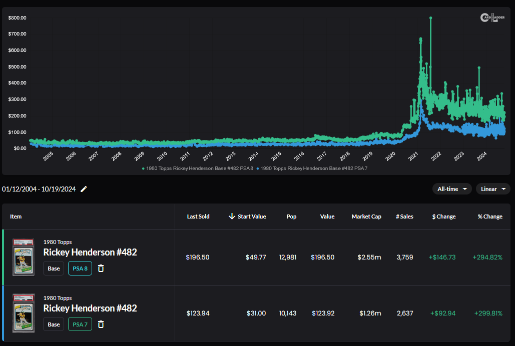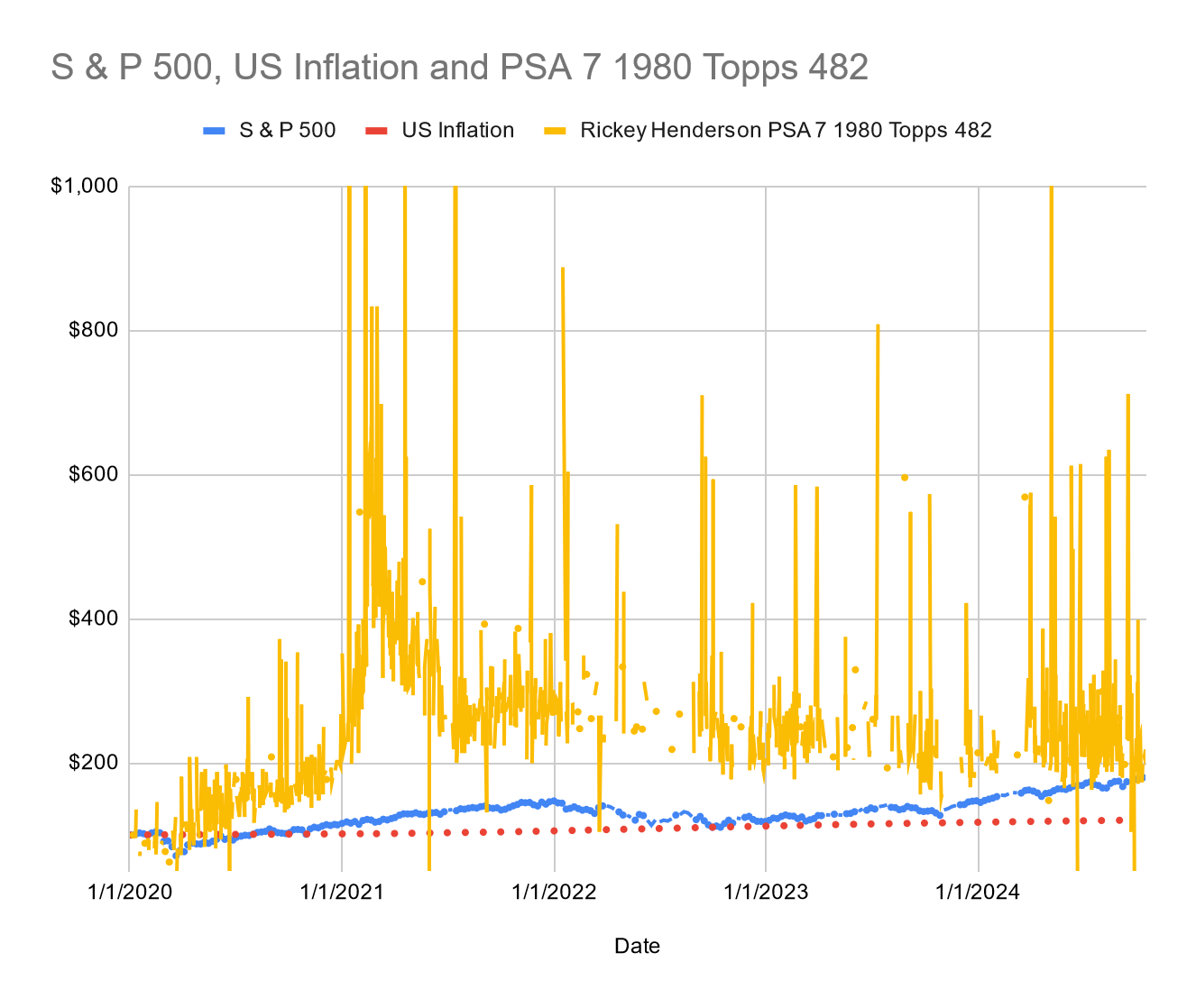My Background
My family recently moved and we got a nice profit on the sale of our house. A close friend strongly encouraged me to spend a couple thousand and splurge on myself. Splurging to me sounds wasteful, so I was very reluctant. I considered buying a new bicycle, but I like my current one. My cousin has a frig in her garage that is covered in baseball cards. I've been wanting to do something similar. A couple weeks ago, I went online to buy a bunch of cheap baseball cards to make something artistic or fun. I thought it might be cool to use all Rickey Henderson rookie cards. This is a card I almost bought a couple times, but never did. Rickey Henderson was my favorite baseball player as a kid. I probably have 100s of his cards, hopefully, in my bedroom at my parents house. I look forward to retrieving them on my next trip home. To my surprise, Rickey Henderson's rookie card is expensive!
Introduction
Rickey Henerdson's rookie card, 1980 Topps #482, is the most valuable baseball card of the 1980s. On August 24th, 2024, a gem mint PSA 10, the highest graded rating from PSA, sold for $180,000 at a Heritage Auction.
The 1980s mark the shift in mass producing baseball cards. In 1980, Topps was the only major card company that produced a set of baseball cards (there are some smaller obscure sets from 1980). In 1981, Fleer and Donruss joined Topps in the baseball card market. By 1989, there were six major brands of baseball cards: Topps, Fleer, Donruss, Score, Upper Deck, and Bowman. Topps has not released official numbers of printed cards from the 1980s, but several sources online suggest the 1980 prints were in the millions. Estimates for the 1989 cohorts put each company printing in the 2-5 million range. The late 1980s and early 1990s marked the peak years of overproduction. If you grew up in the early 1990s, you'll remember how many more cards shops there were. You'll remember sports cards were everywhere. Grocery stores were some of the best places to buy cards. People were opening businesses so they could buy cards whole sale and by the boxes. It was a wild time.
Let's compare Ken Griffey Jr. (KGJ), peak overproduction, with Rickey Henderson (RH), beginning of mass production.
KGJ's, a rookie in 1989, represents the opposite of RH, a rookie in 1980. The KGJ has six RCs, one from each card brand. RH has 1, Topps #482. 1989 was the first year of Upper Deck. KGJ, the number draft pick, was giving the first card, #1, of the set. Upper Deck printed less cards than the other brands and was considered a more premium card company. KGJ 1989 Upper Deck #1 (RC) is another one of the most popular and valuable cards of the 1980s. Considering KGJ has 6 different RCs, there are over ten times more KGJ RCs between 15-25 million prints, than RH RC, 1-2 million prints.
KGJ has a lot more supply. There is another key difference: time.
PSA is the top grading company. Results of PSA sales show that KGJ is more popular (more demand) than RH, but due to the difference in supply, RH's cards are a lot more valuable than KGJ. See Mickey Mantle below for an even more extreme comparison. The links have more data.
RH's RC, 1980 Topps #482, has 25 gem mint PSA 10 graded cards out of 38,810 cards graded by PSA.

KGJ's best RC, 1989 Upper Deck #1, has 4,179 gem mint PSA 10 grading out of 110, 584 graded cards by PSA.

Let's compare with one of the most iconic baseball card, Mickey Mantle's (MM) RC, 1951 Bowan #253, has 1 gem mint PSA 10 grading, and 9 mint PSA 9 grading, out of 2,5778 total grades. A mint PSA 9 sold for over $3,000,000 in 2022.

One more to bridge the gap between MM and RH. Reggie Jackson's (RJ) RC, 1969 Topps #260, also has 1 gem mint PSA 10 graded card, with 42 mint PSA 9 grades. There are a total of 11,552 cards graded by PSA. The RJ RC sold for over $1,000,000 in 2021.

All four of these players are popular all time great hall of fame outfielders.

More to Come
I got a friend, who is a data scientist, who seems to be interested enough to help me. We're going to start by investigate RH's 1980 Topps #482.
I suspect RH RC is a bad long term investment. I'm around middle age and have disposable income to spend on expensive piece of cardboard. I think I'm a perfect example of a growing demand for RH RCs and sports cards from the 80s and 90s in general. As my collecting peers grow old and die, will there be enough young collectors coming up to keep the demand for these baseball cards? I think for Mantle yes. RH maybe. KGJ no way.
My initial feeling is that baseball cards, trading cards and collectibles in general, are "too" volatile to seriously consider as investments. People should only spend disposable income and the activity of buying/collecting should be largely entertainment. Trading, short term buying and selling, is probably the most profitable activity in sports cards.
I suspect cards might not even keep up with inflation (I'm sure there is research already on this). I'm curious how RH RC performs compared with stocks, other investments, and art.
I'm curious to explore when or at what price do most of the know cards come out and get graded and or sold? I don't expect many, if any, new gem mint Mantle RCs to pop up. KGJ on the other hand could have 100s-1000s still hiding. And Henderson? I suspect the RH card is more like the Mantle card than the KGJ card. There must be 1000s of RH RCs in basements, attics, and garages, but how many are in mint or gem mint condition? How many collectors are sitting on gem mints waiting for the right price to grade and sell theirs?
I want to see how basic economics principles predict and explain Rickey Henderson's RC over time. I'm going to make a prediction at the end for 1, 5, and 20 years in the future. It'll be interesting to see how I do.


